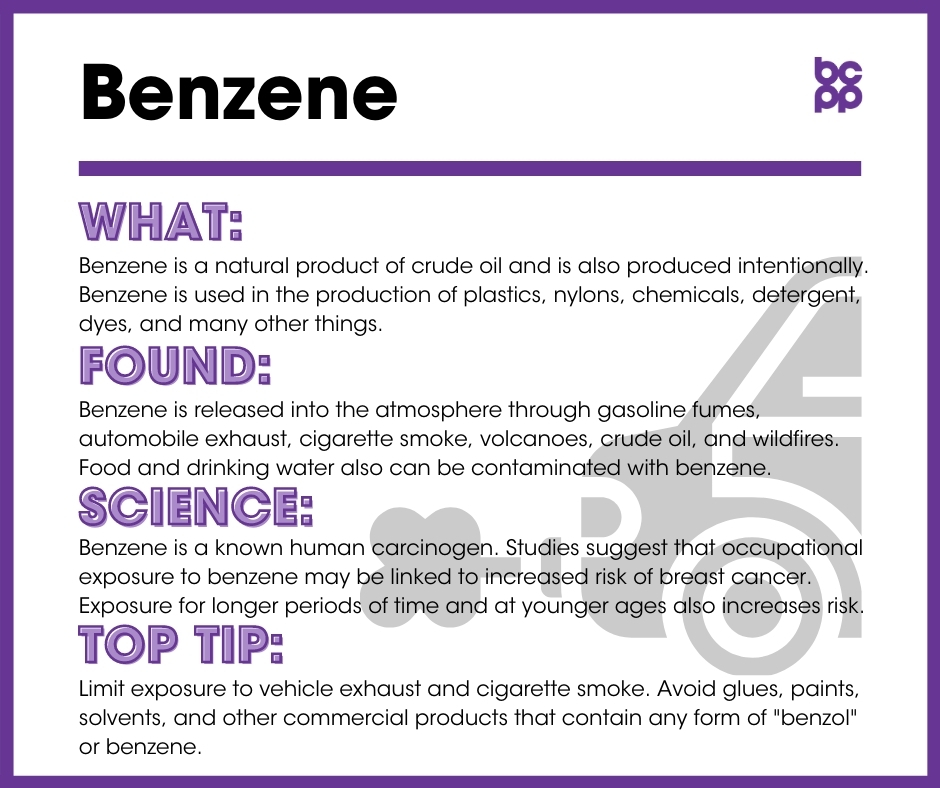Benzene
What is benzene?
Benzene is a useful organic solvent. It is a natural product of crude oil and is also produced intentionally. Benzene is used in the production of plastics, nylons, chemicals, detergent, dyes and many other things.[1],[2]
Where is benzene found?
Benzene is released into the atmosphere through gasoline fumes, automobile exhaust, cigarette smoke, volcanoes, crude oil and wildfires. Traces of benzene can be found in a variety of chemicals. Food and drinking water also can be contaminated with benzene.[3]
What evidence links benzene to breast cancer?
Benzene is a known human carcinogen.[4] Several studies suggest that occupational exposure to benzene and other solvents may be linked to increased risk of breast cancer.[5] Exposure for longer periods of time and at younger ages increased the risk for breast cancer.[6],[7]
- Women in Shanghai who were exposed to benzene through various occupations showed an elevated risk for breast cancer.[8]
- A group of 797 female shoemakers in Italy were found to have a slightly higher breast cancer incidence and mortality rate after working with benzene-based glues.[9]
- One study found that men who had been exposed to combustion products of automobiles for over three months experienced an elevated risk for breast cancer.[10]
- Women who served on active duty in the military and were exposed to solvents such as benzene for over a year also experienced an elevated incidence of breast cancer.[11]
- A study of a Marine Corps base camp in North Carolina found that men who drank water containing benzene and other contaminants experienced elevated rates of breast cancer 10 years later.[12]
Who is most likely to be exposed to benzene?
- People working in occupations with potential benzene exposure, such as auto mechanics.
Who is most vulnerable to the health effects of benzene?
Women who are exposed earlier and for a longer period of time may be at elevated risk.[13],[14]
What are the top tips to avoid exposure benzene?
- Minimize exposure to vehicle exhaust.[15]
- Limit use of commercial products that contain any form of “benzol,” which could contain traces of benzene.[16]
- Limit exposure to cigarette smoke.[17]
- Avoid glues, paints and solvents that contain benzene.[18],[19]
Reviewed 2019
[2] IARC Monographs on the Evaluation of Carcinogenic Risks to Humans Volume 100F. “Chemical Agents and Related Occupations.” Last modified 2012. http://monographs.iarc.fr/ENG/Monographs/vol100F/mono100F-28.pdf.
[3] National Toxicology Program. 14th Report on Carcinogens. Research Triangle Park, NC: U.S. Department of Health and Human Services, Public Health Service, 2016. Accessed online October 23, 2020. https://ntp.niehs.nih.gov/ntp/roc/content/profiles/benzene.pdf.
[4] Brody, Julia Green, and Ruthann A Rudel. “Environmental pollutants and breast cancer.” Environmental Health Perspectives 111,8 (2003): 1007-19. doi:10.1289/ehp.6310.
[5] Fenga, Concettina. “Occupational exposure and risk of breast cancer.” Biomedical Reports 4,3 (2016): 282-292. doi:10.3892/br.2016.575.
[6] Hansen, Johnni. “Elevated risk for male breast cancer after occupational exposure to gasoline and vehicular combustion products.” American Journal of Industrial Medicine 37 (2000): 349–352. doi:10.1002/(SICI)1097-0274(200004)37:4<349::AID-AJIM4>3.0.CO;2-L.
[7] Rennix, Christopher P., Margaret M. Quinn, Paul J. Amoroso, Ellen A. Eisen and David H. Wegman MD. “Risk of breast cancer among enlisted army women occupationally exposed to volatile organic compounds.” American Journal of Industrial Medicine 48 (2005): 157–167. doi:10.1002/ajim.20201.
[8] Petralia, S A et al. “Occupational risk factors for breast cancer among women in Shanghai.” American Journal of Industrial Medicine 34, 5 (1998): 477-83. doi:10.1002/(sici)1097-0274(199811)34:5<477::aid-ajim8>3.0.co;2-n.
[9] Costantini, Adele Seniori et al. “Exposure to benzene and risk of breast cancer among shoe factory workers in Italy.” Tumori 95 no.1 (2009): 8-12. doi:10.1177/030089160909500102.
[10] Hansen, Johnni. “Elevated risk for male breast cancer after occupational exposure to gasoline and vehicular combustion products.” American Journal of Industrial Medicine 37 (2000): 349–352. doi:10.1002/(SICI)1097-0274(200004)37:4<349::AID-AJIM4>3.0.CO;2-L.
[11] Rennix, Christopher P., Margaret M. Quinn, Paul J. Amoroso, Ellen A. Eisen and David H. Wegman MD. “Risk of breast cancer among enlisted army women occupationally exposed to volatile organic compounds.” American Journal of Industrial Medicine 48 (2005): 157–167. doi:10.1002/ajim.20201.
[12] Ruckart, P.Z., Bove, F.J., Shanley, E. et al. “Evaluation of contaminated drinking water and male breast cancer at Marine Corps Base Camp Lejeune, North Carolina: a case control study.” Environmental Health 14, 74 (2015). doi:10.1186/s12940-015-0061-4.
[13] Hansen, Johnni. “Elevated risk for male breast cancer after occupational exposure to gasoline and vehicular combustion products.” American Journal of Industrial Medicine 37 (2000): 349–352. doi:10.1002/(SICI)1097-0274(200004)37:4<349::AID-AJIM4>3.0.CO;2-L.
[14] Rennix, Christopher P., Margaret M. Quinn, Paul J. Amoroso, Ellen A. Eisen and David H. Wegman MD. “Risk of breast cancer among enlisted army women occupationally exposed to volatile organic compounds.” American Journal of Industrial Medicine 48 (2005): 157–167. doi:10.1002/ajim.20201.
[15] Hansen, Johnni. “Elevated risk for male breast cancer after occupational exposure to gasoline and vehicular combustion products.” American Journal of Industrial Medicine 37 (2000): 349–352. doi:10.1002/(SICI)1097-0274(200004)37:4<349::AID-AJIM4>3.0.CO;2-L.
[16] Huff, J E et al. “Multiple-site carcinogenicity of benzene in Fischer 344 rats and B6C3F1 mice.” Environmental Health Perspectives 82 (1989): 125-63. doi:10.1289/ehp.8982125.
[17] National Toxicology Program. 14th Report on Carcinogens. Research Triangle Park, NC: U.S. Department of Health and Human Services, Public Health Service, 2016. Accessed online October 23, 2020. https://ntp.niehs.nih.gov/ntp/roc/content/profiles/benzene.pdf.
[18] World Health Organization. “Exposure to Benzene: A Major Public Health Concern.” Last modified 2010. http://www.who.int/ipcs/features/benzene.pdf.
[19] Costantini, Adele Seniori et al. “Exposure to benzene and risk of breast cancer among shoe factory workers in Italy.” Tumori 95, 1 (2009): 8-12. doi:10.1177/030089160909500102.






